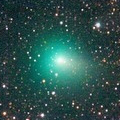
|
Now it is very bright as 9.2 mag (Apr. 21, Carlos Labordena). It stays observable at 9 mag in excellent condition in April.
Date(TT) R.A. (2000) Decl. Delta r Elong. m1 Best Time(A, h)
Apr. 24 16 4.21 29 9.8 0.464 1.348 129 8.8 2:02 ( 0, 84)
May 1 13 53.40 33 13.4 0.540 1.421 130 9.5 23:06 ( 0, 88)
|
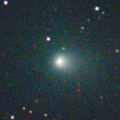
|
It brightened rapidly. Now it is very bright as 11.1 mag (Apr. 21, Osamu Miyazaki). It stays observable at 11 mag in good condition for a long time from spring to summer.
Date(TT) R.A. (2000) Decl. Delta r Elong. m1 Best Time(A, h)
Apr. 24 13 50.36 33 27.6 1.440 2.254 133 11.4 23:39 ( 0, 88)
May 1 13 45.87 32 23.3 1.424 2.222 131 11.3 23:07 ( 0, 87)
|
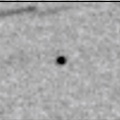
|
Now it is 11.2 mag (Apr. 19, Chris Wyatt). Appearing in the morning sky in the Southern Hemisphere. In the Northern Hemisphere, it will appear in the morning sky in June.
Date(TT) R.A. (2000) Decl. Delta r Elong. m1 Best Time(A, h)
Apr. 24 0 2.34 -5 6.8 2.144 1.449 35 11.8 3:46 (273, -5)
May 1 0 23.09 -3 30.9 2.141 1.468 37 11.9 3:36 (271, -4)
|
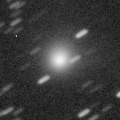
|
Now it is 12.9 mag (Apr. 4, Thomas Lehmann). It will brighten up to 10 mag in winter in 2022. In the Northern Hemisphere, it stays observable in good condition for a long time, although it becomes extremely low temporarily from May to June. In the Southern Hemisphere, it is not observable until November.
Date(TT) R.A. (2000) Decl. Delta r Elong. m1 Best Time(A, h)
Apr. 24 3 2.93 50 49.1 4.980 4.256 39 12.8 20:10 (142, 16)
May 1 3 16.37 50 44.2 4.986 4.223 36 12.7 20:18 (144, 13)
|
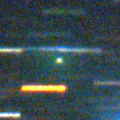
|
Now it is 13.1 mag (Apr. 22, Michael Jager). Brightenening very rapidly. It will brighten up to 11 mag from May to August. In the Southern Hemisphere, it stays observable in excellent condition for a long time. In the Northern Hemisphere, it stays observable in good condition for a while. But it becomes extremely low after July.
Date(TT) R.A. (2000) Decl. Delta r Elong. m1 Best Time(A, h)
Apr. 24 19 6.49 5 53.4 0.626 1.300 103 13.2 3:46 (326, 57)
May 1 19 31.54 4 0.3 0.580 1.275 103 12.8 3:36 (325, 54)
|
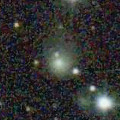
|
Now it is 13.2 mag (Apr. 21, Toshihiko Ikemura, Hirohisa Sato). It is expected to be observable at 5-6 mag for a long time from 2022 to 2023. In the Northern Hemisphere, it is not observable at the high light from 2022 summer to 2023 summer. In the Southern Hemisphere, it stays extremely low for a while. But it will be observable in good condition at the high light.
Date(TT) R.A. (2000) Decl. Delta r Elong. m1 Best Time(A, h)
Apr. 24 18 24.06 41 27.2 6.297 6.542 99 13.2 3:46 (221, 81)
May 1 18 21.28 42 1.0 6.192 6.485 102 13.1 3:36 (195, 83)
|
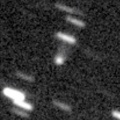
|
Now it is 14.9 mag (Apr. 19, Chris Wyatt). It is expected to brighten up to 13 mag from spring to summer. But actually, it is fainter than this ephemeris recently. In the Southern Hemisphere, it stays observable in good condition for a long time. In the Northern Hemisphere, it is not observable until July in 2022.
Date(TT) R.A. (2000) Decl. Delta r Elong. m1 Best Time(A, h)
Apr. 24 20 3.16 -72 10.9 3.286 3.637 102 13.2 3:46 (350,-19)
May 1 20 21.74 -73 51.2 3.232 3.628 105 13.1 3:36 (351,-21)
|

|
It brightened up to 10.5 mag in early March (Mar. 8, Bob King). Now it is fading. But it is still bright as 12.6 mag (Apr. 4, Sandor Szabo). In the Northern Hemisphere, it stays observable in the evening low sky until early June while the comet will be fading. It is not observable in the Southern Hemisphere.
Date(TT) R.A. (2000) Decl. Delta r Elong. m1 Best Time(A, h)
Apr. 24 4 18.54 34 19.3 1.974 1.317 36 13.2 20:10 (119, 19)
May 1 4 51.34 34 1.6 2.075 1.401 36 13.5 20:18 (119, 18)
|

|
It brightened up to 11.6 mag in winter (Feb. 18, Thomas Lehmann). Now it is fading. It has already faded down to 14.2 mag (Apr. 12, Chris Wyatt). In the Southern Hemisphere, it stays observable in good condition after this. In the Northern Hemisphere, it will never be observable after this.
Date(TT) R.A. (2000) Decl. Delta r Elong. m1 Best Time(A, h)
Apr. 24 4 12.70 -60 5.3 2.511 2.489 77 13.4 20:10 ( 36,-31)
May 1 4 20.81 -58 6.1 2.591 2.550 76 13.5 20:18 ( 39,-34)
|
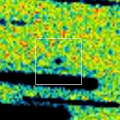
|
It was expected to brighten up to 13 mag from spring to summer. But actually, now it is extremely faint as 19.0 mag (Mar. 22, A. C. Gilmore, P. M. Kilmartin). In the Southern Hemisphere, it stays observable in good condition for a long time. In the Northern Hemisphere, it is not observable until late August.
Date(TT) R.A. (2000) Decl. Delta r Elong. m1 Best Time(A, h)
Apr. 24 23 5.11 -44 40.4 1.678 1.644 70 13.8 3:46 (314,-16)
May 1 23 46.19 -45 52.2 1.619 1.613 71 13.6 3:36 (312,-20)
|
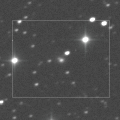
|
Now it is 12.9 mag (Apr. 19, Chris Wyatt). It stays 13-14 mag until early summer. In the Southern Hemisphere, it stays observable in good condition for a long time. It is getting higher slowly also in the Northern Hemisphere.
Date(TT) R.A. (2000) Decl. Delta r Elong. m1 Best Time(A, h)
Apr. 24 16 27.18 -35 43.5 2.515 3.356 140 13.8 2:21 ( 0, 19)
May 1 16 8.33 -34 8.7 2.439 3.357 151 13.7 1:35 ( 0, 21)
|
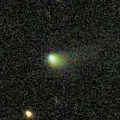
|
Now it is 14.4 mag (Apr. 19, Chris Wyatt). It stays 13-14 mag from 2020 to 2021. It will be observable in good condition after this in the Southern Hemisphere. It locates somewhat low in the Northern Hemisphere.
Date(TT) R.A. (2000) Decl. Delta r Elong. m1 Best Time(A, h)
Apr. 24 19 20.55 -25 27.1 2.445 2.883 105 13.8 3:46 (338, 26)
May 1 19 24.65 -25 58.5 2.361 2.887 111 13.7 3:36 (341, 27)
|
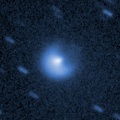
|
Now it is not observable. It will appear in the morning sky in July.
Date(TT) R.A. (2000) Decl. Delta r Elong. m1 Best Time(A, h)
Apr. 24 3 13.41 26 5.3 6.804 5.874 20 13.9 20:10 (121, 2)
May 1 3 19.41 26 23.9 6.839 5.876 15 13.9 20:18 (125, -2)
|
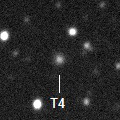
|
Now it is 14.1 mag (Apr. 12, Chris Wyatt). It is expected to brighten up to 11.5 mag in 2022. It is observable in excellent condition in the Southern Hemisphere. In the Northern Hemisphere, it is observable in the low sky until May.
Date(TT) R.A. (2000) Decl. Delta r Elong. m1 Best Time(A, h)
Apr. 24 8 7.13 -30 10.3 5.196 5.405 96 14.3 20:10 ( 30, 18)
May 1 8 10.70 -29 9.8 5.230 5.371 92 14.2 20:18 ( 37, 15)
|
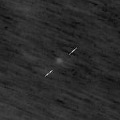
|
It will brighten up to 10 mag from summer to autumn, and it will be observable in excellent condition. Appearing in the morning sky.
Date(TT) R.A. (2000) Decl. Delta r Elong. m1 Best Time(A, h)
Apr. 24 23 18.71 0 2.8 2.727 2.112 43 14.5 3:46 (275, 7)
May 1 23 33.53 1 28.3 2.637 2.072 46 14.2 3:36 (274, 9)
|

|
It will brighten up to 14.5 mag from spring to summer. In the Southern Hemisphere, it stays observable in excellent condition for a long time. In the Northern Hemisphere, it is not observable after this.
Date(TT) R.A. (2000) Decl. Delta r Elong. m1 Best Time(A, h)
Apr. 24 0 21.21 -52 54.0 2.826 2.646 69 14.9 3:46 (315,-31)
May 1 0 41.84 -55 15.2 2.741 2.648 74 14.8 3:36 (318,-32)
|
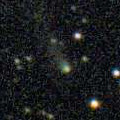
|
Now it is 14.9 mag (Apr. 18, Toshihiko Ikemura, Hirohisa Sato). It will stay at 14-15 mag for a long time from 2021 to 2022. It stays observable in good condition after this while brightening gradually.
Date(TT) R.A. (2000) Decl. Delta r Elong. m1 Best Time(A, h)
Apr. 24 18 12.40 1 2.4 4.669 5.208 117 15.0 3:46 (351, 56)
May 1 18 7.84 0 42.2 4.555 5.193 124 14.9 3:33 ( 0, 56)
|

|
Now it is 15.3 mag (Apr. 19, Chris Wyatt). It stays 14-15 mag until the end of 2021. In the Southern Hemisphere, it stays observable in good condition for a long time. In the Northern Hemisphere, it is not observable until June.
Date(TT) R.A. (2000) Decl. Delta r Elong. m1 Best Time(A, h)
Apr. 24 23 15.79 -38 13.8 4.667 4.333 64 15.0 3:46 (307,-14)
May 1 23 21.49 -37 32.3 4.594 4.337 69 15.0 3:36 (308,-12)
|

|
Now it is 15.6 mag (Apr. 12, Chris Wyatt). It stays 15 mag until summer. In the Southern Hemisphere, it stays observable in good condition until June. In the Northern Hemisphere, it is observable in the low sky from March to May.
Date(TT) R.A. (2000) Decl. Delta r Elong. m1 Best Time(A, h)
Apr. 24 6 56.90 -19 27.9 2.175 2.207 78 15.1 20:10 ( 50, 17)
May 1 7 8.18 -15 31.9 2.209 2.170 74 15.1 20:18 ( 57, 16)
|

|
Now it is 14.9 mag (Apr. 18, Toshihiko Ikemura, Hirohisa Sato). It will brighten up to 13 mag in 2022. In 2021, it is observable at 15-16 mag in good condition.
Date(TT) R.A. (2000) Decl. Delta r Elong. m1 Best Time(A, h)
Apr. 24 13 15.35 -0 14.1 2.686 3.657 162 15.3 23:04 ( 0, 55)
May 1 13 11.01 -0 3.1 2.704 3.641 154 15.3 22:32 ( 0, 55)
|
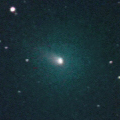
|
It brightening very rapidly up to 12.5 mag in early February (Feb. 8, Michael Jager). Now it is fading. It has already faded down to 14.9 mag (Apr. 12, Chris Wyatt). In the Southern Hemisphere, it stays observable after this while the comet will be fading. It is not observable after this in the Northern Hemisphere.
Date(TT) R.A. (2000) Decl. Delta r Elong. m1 Best Time(A, h)
Apr. 24 4 13.85 -13 48.9 1.838 1.270 41 15.5 20:10 ( 80, -9)
May 1 4 15.24 -15 27.5 1.929 1.320 39 16.3 20:18 ( 83,-17)
|

|
Now it is 15.8 mag (Jan. 16, Slooh.com Canary Islands Observatory). It is not observable until June.
Date(TT) R.A. (2000) Decl. Delta r Elong. m1 Best Time(A, h)
Apr. 24 0 59.74 16 59.8 3.081 2.137 16 15.5 3:46 (247, -3)
May 1 1 14.06 18 55.6 3.076 2.150 19 15.6 3:36 (246, -1)
|

|
It had been observed as 8-9 mag for a long time in 2020. Now it is fading. It has already faded down to 16.4 mag (Mar. 27, Thomas Lehmann). It will be observable in good condition after this in the Southern Hemisphere. It locates extremely low after this in the Northern Hemisphere.
Date(TT) R.A. (2000) Decl. Delta r Elong. m1 Best Time(A, h)
Apr. 24 17 37.04 -42 0.5 3.781 4.446 125 15.5 3:30 ( 0, 13)
May 1 17 31.79 -42 56.6 3.766 4.510 132 15.6 2:57 ( 0, 12)
|

|
It brightened up to 5.6 mag in early December (Dec. 9, Marco Goiato). In mid December, it was visible at about 3 mag in the SOHO spacecraft images (Dec. 18, Hirohisa Sato). Appearing in the morning sky.
Date(TT) R.A. (2000) Decl. Delta r Elong. m1 Best Time(A, h)
Apr. 24 23 42.65 11 54.5 3.271 2.514 35 15.6 3:46 (262, 9)
May 1 23 49.87 12 54.7 3.309 2.612 39 15.8 3:36 (262, 12)
|

|
Now it is 16.1 mag (Apr. 20, Toshihiko Ikemura, Hirohisa Sato). In the Northern Hemisphere, it stays observable at 15-16 mag for a long time from spring to early 2022. In the Southern Hemisphere, it is not observable until the end of 2021.
Date(TT) R.A. (2000) Decl. Delta r Elong. m1 Best Time(A, h)
Apr. 24 19 51.50 72 14.6 3.259 3.222 78 15.7 3:46 (193, 50)
May 1 19 27.58 75 12.5 3.223 3.198 79 15.6 3:36 (187, 49)
|
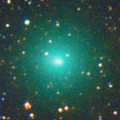
|
It brightened up to 8.2 mag in autumn (Oct. 13, Chris Wyatt). It faded down to 13.0 mag in February (Feb. 14, Sandor Szabo). It is not observable after this.
Date(TT) R.A. (2000) Decl. Delta r Elong. m1 Best Time(A, h)
Apr. 24 2 14.10 12 18.6 3.443 2.438 2 15.6 20:10 (119,-17)
May 1 2 26.21 13 24.6 3.490 2.483 2 15.8 3:36 (238,-18)
|
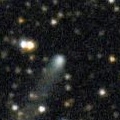
|
Now it is 16.1 mag (Apr. 20, Toshihiko Ikemura, Hirohisa Sato). It stays 15-16 mag until June. In the Northern Hemisphere, it stays observable in good condition for a long time. In the Southern Hemisphere, it will be observable in the extremely low sky only in next spring.
Date(TT) R.A. (2000) Decl. Delta r Elong. m1 Best Time(A, h)
Apr. 24 19 12.51 46 23.3 5.030 5.125 89 15.7 3:46 (227, 71)
May 1 19 7.24 48 15.4 5.012 5.152 92 15.8 3:36 (214, 73)
|
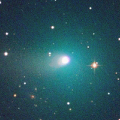
|
Brightened rapidly, and it brightened up to 9.7 mag in November (Nov. 15, Chris Wyatt). Now it is fading. It has already faded down to 14.9 mag (Apr. 4, Sandor Szabo). In the Northern Hemisphere, it stays observable in good condition for a long time. In the Southern Hemisphere, it locates extremely low after this.
Date(TT) R.A. (2000) Decl. Delta r Elong. m1 Best Time(A, h)
Apr. 24 6 43.83 38 51.0 2.342 2.142 66 15.7 20:10 (112, 47)
May 1 7 1.38 38 7.0 2.458 2.192 62 16.0 20:18 (112, 44)
|

|
It has not been observed yet in this apparition. The condition of this apparition is bad. It brightens up to 15.5 mag in spring, however, it is not observable until autumn when it becomes fainter than 19 mag.
Date(TT) R.A. (2000) Decl. Delta r Elong. m1 Best Time(A, h)
Apr. 24 2 0.51 12 58.9 2.288 1.283 1 15.9 3:46 (240,-17)
May 1 2 24.88 15 24.3 2.265 1.258 1 15.8 3:36 (237,-16)
|

|
Now it is 16.0 mag (Apr. 4, Michael Jager). Toshihiko Ikemura and Hirohisa Sato reported it was bright as 14.7 mag on Apr. 18. It is expected to brighten up to 13 mag in 2022. In the Southern Hemisphere, it stays observable in good condition for a long time. In the Northern Hemisphere, it stays observable until June, but it will not be observable at the high light.
Date(TT) R.A. (2000) Decl. Delta r Elong. m1 Best Time(A, h)
Apr. 24 12 59.82 -20 54.7 4.015 4.982 162 16.0 22:48 ( 0, 34)
May 1 12 51.17 -20 52.6 4.002 4.935 155 15.9 22:12 ( 0, 34)
|
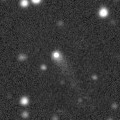
|
Now it is 15.7 mag (Apr. 4, Michael Jager). It stays observable at 16 mag from 2021 to 2022. Toshihiko Ikemura and Hirohisa Sato reported it was very bright as 14.2 mag on Apr. 19.
Date(TT) R.A. (2000) Decl. Delta r Elong. m1 Best Time(A, h)
Apr. 24 14 3.17 -13 52.3 3.865 4.870 178 16.3 23:52 ( 0, 41)
May 1 13 58.66 -12 17.2 3.858 4.856 171 16.3 23:20 ( 0, 43)
|

|
Now it is 15.4 mag (Apr. 19, Toshihiko Ikemura, Hirohisa Sato). In the Northern Hemisphere, it stays observable for a long time while it is getting fainter slowly. In the Southern Hemisphere, it will never be observable again.
Date(TT) R.A. (2000) Decl. Delta r Elong. m1 Best Time(A, h)
Apr. 24 14 59.11 69 33.7 5.518 5.731 97 16.3 0:52 (180, 56)
May 1 14 43.67 69 11.8 5.590 5.779 95 16.4 0:09 (180, 56)
|
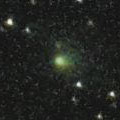
|
Now it is 15.5 mag (Apr. 5, Sandor Szabo). It stays observable at 16 mag in good condition from April to May.
Date(TT) R.A. (2000) Decl. Delta r Elong. m1 Best Time(A, h)
Apr. 24 14 7.11 12 21.0 1.419 2.368 154 16.4 0:02 ( 0, 67)
May 1 13 37.52 10 16.2 1.441 2.374 151 16.4 22:57 ( 0, 65)
|

|
Now it is 17-17.5 mag (Apr. 10, Alan Hale). It will brighten very rapidly, and it will brighten up to 10 mag from July to August. It stays observable in the morning sky for a long time.
Date(TT) R.A. (2000) Decl. Delta r Elong. m1 Best Time(A, h)
Apr. 24 21 51.67 -20 14.4 1.477 1.487 70 17.1 3:46 (305, 11)
May 1 22 17.96 -18 1.9 1.388 1.423 70 16.4 3:36 (301, 11)
|

|
It brightened up to 10.5 mag in early February (Feb. 6, Marco Goiato). Now it is fading rapidly. It has already faded down to 16.6 mag (Apr. 11, Toshihiko Ikemura, Hirohisa Sato). In the Northern Hemisphere, it stays observable for a long time after this. In the Southern Heimsphere, it will never be observable again.
Date(TT) R.A. (2000) Decl. Delta r Elong. m1 Best Time(A, h)
Apr. 24 5 11.11 53 47.2 2.300 1.906 54 16.4 20:10 (136, 35)
May 1 5 17.39 55 4.3 2.440 1.970 51 16.8 20:18 (138, 31)
|

|
Now it is 17.1 mag (Apr. 20, Toshihiko Ikemura, Hirohisa Sato). It is observable at 16.5 mag from spring in 2020 to summer in 2021.
Date(TT) R.A. (2000) Decl. Delta r Elong. m1 Best Time(A, h)
Apr. 24 17 20.51 -14 49.6 4.086 4.827 132 16.4 3:13 ( 0, 40)
May 1 17 12.27 -15 20.8 4.013 4.843 141 16.4 2:38 ( 0, 40)
|

|
Now it is 16.5 mag (Apr. 20, Toshihiko Ikemura, Hirohisa Sato). It is observable at 16 mag from 2020 to 2021. In the Southern Hemisphere, it is not observable until summer.
Date(TT) R.A. (2000) Decl. Delta r Elong. m1 Best Time(A, h)
Apr. 24 23 14.44 42 56.3 6.589 5.958 47 16.5 3:46 (236, 30)
May 1 23 16.47 43 9.1 6.554 5.961 50 16.5 3:36 (237, 32)
|
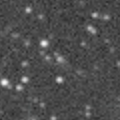
|
Now it is 16.6 mag (Apr. 21, Toshihiko Ikemura, Hirohisa Sato). It stays observable at 16.5-17 mag in good condition until October.
Date(TT) R.A. (2000) Decl. Delta r Elong. m1 Best Time(A, h)
Apr. 24 17 31.95 -29 52.1 4.260 4.961 129 16.6 3:25 ( 0, 25)
May 1 17 28.59 -28 58.6 4.165 4.951 137 16.5 2:54 ( 0, 26)
|
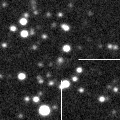
|
Now it is 16.3 mag (Apr. 19, Toshihiko Ikemura, Hirohisa Sato). It stays at 16-17 mag from 2020 to 2021. In the Northern Hemisphere, it stays observable in good condition for a long time. It locates extremely low in the Southern Hemisphere.
Date(TT) R.A. (2000) Decl. Delta r Elong. m1 Best Time(A, h)
Apr. 24 19 46.58 42 47.0 8.857 8.824 84 16.7 3:46 (242, 67)
May 1 19 45.38 43 49.4 8.804 8.825 87 16.7 3:36 (237, 70)
|
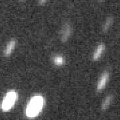
|
Now it is 17.0 mag (Apr. 1, Michael Jager). It is expected to brighten up to 11 mag in 2023. In the Northern Hemisphere, it stays observable in good condition for a long time. It locates extremely low in the Southern Hemisphere.
Date(TT) R.A. (2000) Decl. Delta r Elong. m1 Best Time(A, h)
Apr. 24 18 22.67 47 7.2 6.724 6.924 97 16.7 3:46 (202, 77)
May 1 18 17.40 47 58.6 6.638 6.879 99 16.7 3:36 (185, 77)
|
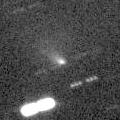
|
Now it is 16.5 mag (Mar. 30, Thomas Lehmann). It will be fading after this. In the Northern Hemisphere, it will be getting lower gradually, and will be too low to observe in May. In the Southern Hemisphere, it stays observable in good condition after this.
Date(TT) R.A. (2000) Decl. Delta r Elong. m1 Best Time(A, h)
Apr. 24 6 31.05 4 29.8 1.553 1.465 65 16.7 20:10 ( 73, 29)
May 1 6 53.76 2 31.7 1.620 1.512 65 16.9 20:18 ( 74, 25)
|
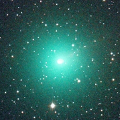
|
It brightened up to 7.3 mag in November (Nov. 7, Marco Goiato). Now it is fading. It has already faded down to 18.2 mag (Apr. 18, Toshihiko Ikemura, Hirohisa Sato). In the Northern Hemisphere, it stays observable in excellent condition for a long time. In the Southern Hemisphere, it stays locating extremely low after this.
Date(TT) R.A. (2000) Decl. Delta r Elong. m1 Best Time(A, h)
Apr. 24 7 46.90 42 18.8 2.763 2.736 77 16.8 20:10 (115, 60)
May 1 7 58.78 41 30.4 2.916 2.808 73 17.1 20:18 (114, 55)
|
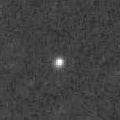
|
Now it is 17.0 mag (Apr. 11, Toshihiko Ikemura, Hirohisa Sato). It is expected to brighten up to 10 mag in 2023. In the Northern Hemisphere, it stays observable in good condition until 2023 autumn. In the Southern Hemipshere, it stays extremely low until mid July, then it becomes unobservable for a while. But it becomes observable in good condition after 2023 summer.
Date(TT) R.A. (2000) Decl. Delta r Elong. m1 Best Time(A, h)
Apr. 24 12 29.27 38 37.4 6.840 7.447 123 16.9 22:18 (180, 86)
May 1 12 24.34 38 51.3 6.863 7.395 118 16.9 21:46 (180, 86)
|
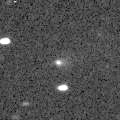
|
First return of a new periodic comet which brightened up to 16 mag in 2014. Now it is 16.0 mag (Apr. 4, Sandor Szabo). It stays observable at 16-17 mag in good condition until July.
Date(TT) R.A. (2000) Decl. Delta r Elong. m1 Best Time(A, h)
Apr. 24 12 16.16 10 45.1 1.347 2.240 143 16.9 22:05 ( 0, 66)
May 1 12 12.24 9 43.9 1.377 2.225 137 16.9 21:34 ( 0, 65)
|

|
First return of a new periodic comet which brightened up to 14-15 mag in 2006. Now it is 15.7 mag (Apr. 14, Toshihiko Ikemura, Hirohisa Sato). It will be fading rapidly after this, and it will be fainter than 18 mag in May.
Date(TT) R.A. (2000) Decl. Delta r Elong. m1 Best Time(A, h)
Apr. 24 13 16.45 21 47.5 1.083 1.983 143 16.9 23:06 ( 0, 77)
May 1 13 16.22 21 29.8 1.146 2.018 138 17.2 22:38 ( 0, 76)
|

|
Now it is 16.7 mag (Apr. 11, Toshihiko Ikemura, Hirohisa Sato). It will be fading slowly.
Date(TT) R.A. (2000) Decl. Delta r Elong. m1 Best Time(A, h)
Apr. 24 18 15.74 -15 55.7 6.984 7.532 119 17.0 3:46 (353, 39)
May 1 18 11.84 -15 33.2 6.903 7.556 127 17.0 3:36 ( 0, 39)
|
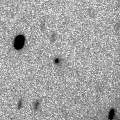
|
Now it is 16.7 mag (Apr. 19, Toshihiko Ikemura, Hirohisa Sato). It will approach to Earth down to 0.2 a.u. in December, and it is expected to brighten up to 4 mag. In the Northern Hemisphere, it stays observable in good condition for a long time until December while the comet is brightening gradually. In the Southern Hemisphere, it is not observable until mid December.
Date(TT) R.A. (2000) Decl. Delta r Elong. m1 Best Time(A, h)
Apr. 24 11 48.95 61 46.3 3.580 3.895 100 17.2 21:37 (180, 63)
May 1 11 31.92 61 24.5 3.581 3.815 95 17.1 20:53 (180, 64)
|

|
First return of a new periodic comet observed at 19 mag in 2015. It is expected to brighten up to 17 mag in early summer, and it will be observable in good condition. But now it is 18.7 mag (Apr. 20, Toshihiko Ikemura, Hirohisa Sato), fainter than this ephemeris.
Date(TT) R.A. (2000) Decl. Delta r Elong. m1 Best Time(A, h)
Apr. 24 18 44.02 -11 16.1 0.786 1.492 112 17.2 3:46 (343, 42)
May 1 18 58.10 -11 20.4 0.753 1.495 115 17.1 3:36 (344, 42)
|

|
It will brighten up to 15 mag from summer to autumn, and it will be observable in good condition. It already locates high in the Southern Hemisphere. It will be getting higher gradually also in the Northern Hemisphere.
Date(TT) R.A. (2000) Decl. Delta r Elong. m1 Best Time(A, h)
Apr. 24 21 42.73 -9 21.1 2.668 2.492 69 17.6 3:46 (298, 20)
May 1 21 53.50 -8 40.0 2.572 2.474 73 17.4 3:36 (298, 22)
|
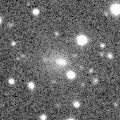
|
Brightened very rapidly up to 15.0 mag (Feb. 4, Michael Jager). Now it is fading. It hasl already faded down to 17.8 mag (Apr. 11, Toshihiko Ikemura, Hirohisa Sato). It is observable in good condition in the Northern Hemisphere. It locates low in the Southern Hemisphere.
Date(TT) R.A. (2000) Decl. Delta r Elong. m1 Best Time(A, h)
Apr. 24 6 23.61 27 12.0 2.413 2.127 61 17.5 20:10 ( 98, 40)
May 1 6 39.84 26 43.6 2.506 2.156 58 17.7 20:18 (100, 36)
|
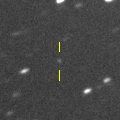
|
Now it is 17.1 mag (Apr. 11, Toshihiko Ikemura, Hirohisa Sato). It stays observable at 17-18 mag for a long time until 2024.
Date(TT) R.A. (2000) Decl. Delta r Elong. m1 Best Time(A, h)
Apr. 24 15 9.05 -9 38.9 8.219 9.191 164 17.5 1:02 ( 0, 45)
May 1 15 4.55 -9 12.2 8.185 9.179 170 17.5 0:30 ( 0, 46)
|

|
Now it is 17.1 mag (Apr. 9, Toshihiko Ikemura, Hirohisa Sato). It brightened rapidly. It stays 17-18 mag for a long time from 2021 to 2022. In the Southern Hemisphere, it stays observable in good condition for a long time. In the Northern Hemisphere, it is observable only until May.
Date(TT) R.A. (2000) Decl. Delta r Elong. m1 Best Time(A, h)
Apr. 24 8 16.80 -7 17.5 5.376 5.542 94 17.5 20:10 ( 41, 39)
May 1 8 15.87 -7 25.0 5.472 5.528 87 17.5 20:18 ( 50, 33)
|

|
Now it is 18.5 mag (Apr. 11, Taras Prystavski). It will brighten up to 9 mag, and will be observable in good condition in winter.
Date(TT) R.A. (2000) Decl. Delta r Elong. m1 Best Time(A, h)
Apr. 24 22 28.69 -13 10.1 2.762 2.418 59 17.8 3:46 (293, 9)
May 1 22 40.46 -12 5.9 2.635 2.364 63 17.6 3:36 (293, 11)
|

|
Now it is 17.5 mag (Apr. 18, Toshihiko Ikemura, Hirohisa Sato). Fading slowly. In 2021, it stays observable at 17-18 mag in good condition until early summer.
Date(TT) R.A. (2000) Decl. Delta r Elong. m1 Best Time(A, h)
Apr. 24 12 59.99 -15 52.6 6.016 6.987 163 17.6 22:49 ( 0, 39)
May 1 12 58.34 -15 17.1 6.063 7.003 157 17.6 22:20 ( 0, 40)
|

|
Now it is 17.1 mag (Apr. 18, Toshihiko Ikemura, Hirohisa Sato). It stays 17-18 mag for a long time from 2021 to 2023.
Date(TT) R.A. (2000) Decl. Delta r Elong. m1 Best Time(A, h)
Apr. 24 10 36.94 12 18.6 4.276 4.889 122 17.6 20:27 ( 0, 67)
May 1 10 36.64 12 13.0 4.362 4.882 115 17.7 20:18 ( 12, 67)
|
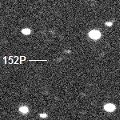
|
Now it is 17.6 mag (Apr. 11, Toshihiko Ikemura, Hirohisa Sato). It will brighten up to 16 mag in 2022. In 2021, it stays observable at 18 mag until September.
Date(TT) R.A. (2000) Decl. Delta r Elong. m1 Best Time(A, h)
Apr. 24 13 36.21 3 45.3 2.426 3.396 161 17.7 23:25 ( 0, 59)
May 1 13 31.93 3 56.2 2.438 3.382 155 17.7 22:53 ( 0, 59)
|
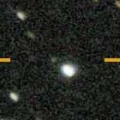
|
Now it is 17.5 mag (Apr. 11, Toshihiko Ikemura, Hirohisa Sato). It is expected to brighten up to 12 mag in 2023. In the Northern Hemisphere, it is observable in good condition in 2021. But it is observable only until November in 2022. In the Southern Hemisphere, it locates extremely low in 2021. But it will be observable in good condition at the high light.
Date(TT) R.A. (2000) Decl. Delta r Elong. m1 Best Time(A, h)
Apr. 24 18 47.45 44 39.6 7.065 7.214 94 17.8 3:46 (223, 76)
May 1 18 45.24 45 9.0 6.971 7.166 97 17.8 3:36 (210, 78)
|

|
It stays 17-18 mag for a long time until 2026. In the Southern Hemisphere, it stays sobservable in good condition for a long time. It is not observable in the Northern Hemisphere. Now it is 19.7 mag (Mar. 13, A. C. Gilmore, P. M. Kilmartin), fainter than this ephemeris.
Date(TT) R.A. (2000) Decl. Delta r Elong. m1 Best Time(A, h)
Apr. 24 8 49.66 -55 11.3 11.116 11.445 106 17.8 20:10 ( 13, -2)
May 1 8 48.31 -54 47.6 11.136 11.429 104 17.8 20:18 ( 18, -4)
|
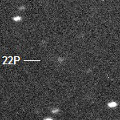
|
Now it is 18.0 mag (Apr. 18, Toshihiko Ikemura, Hirohisa Sato). It will be observable at 11 mag from winter to spring in 2022. In 2021, it is observable until July or August when it brightens up to 16-17 mag.
Date(TT) R.A. (2000) Decl. Delta r Elong. m1 Best Time(A, h)
Apr. 24 10 19.34 15 0.2 2.580 3.171 117 17.9 20:10 ( 1, 70)
May 1 10 18.82 14 58.9 2.634 3.133 110 17.8 20:18 ( 25, 68)
|

|
It brightened rapidly up to 16.3 mag in March (Mar. 16, F. Kugel, J.-G. Bosch). Now it is fading. It has already faded down to 18.0 mag (Apr. 11, Toshihiko Ikemura, Hirohisa Sato). It is observable in excellent condition in the Northern Hemisphere. It locates low in the Southern Hemisphere.
Date(TT) R.A. (2000) Decl. Delta r Elong. m1 Best Time(A, h)
Apr. 24 10 26.08 38 13.7 1.905 2.408 107 17.8 20:15 (180, 87)
May 1 10 15.06 39 48.4 2.065 2.435 98 18.0 20:18 (123, 80)
|

|
Now it is 19.3 mag (Apr. 11, Toshihiko Ikemura, Hirohisa Sato). It will brighten very rapidly, and it will be observable at 10 mag in good condition from October to December. In the Northern Hemisphere, it locates somewhat low at the high light.
Date(TT) R.A. (2000) Decl. Delta r Elong. m1 Best Time(A, h)
Apr. 24 16 52.02 11 5.3 1.258 2.074 132 18.1 2:45 ( 0, 66)
May 1 16 52.26 12 37.9 1.176 2.024 135 17.9 2:17 ( 0, 68)
|

|
First return of a new periodic comet observed at 17 mag in 2014. It has not been observed yet in this apparition. It is expected to brighten up to 17 mag from summer to autumn, and it will be observable in good condition.
Date(TT) R.A. (2000) Decl. Delta r Elong. m1 Best Time(A, h)
Apr. 24 22 25.59 -8 59.5 2.053 1.759 58 18.0 3:46 (290, 12)
May 1 22 42.48 -6 48.6 1.988 1.740 61 17.9 3:36 (289, 14)
|
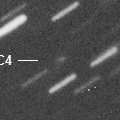
|
Now it is 17.5 mag (Mar. 15, Giuseppe Pappa). It is observable at 18 mag in spring. It is observable in excellent condition in the Southern Hemisphere. It locates low in the Northern Hemisphere.
Date(TT) R.A. (2000) Decl. Delta r Elong. m1 Best Time(A, h)
Apr. 24 13 21.04 -34 9.9 3.634 4.573 156 17.9 23:10 ( 0, 21)
May 1 13 10.93 -32 9.9 3.652 4.583 154 17.9 22:32 ( 0, 23)
|
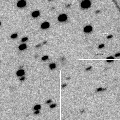
|
Now it is 18.2 mag (Apr. 19, Toshihiko Ikemura, Hirohisa Sato). In the Northern Hemisphere, it stays observable at 18 mag for a long time from 2021 to 2022. It is not observable in the Southern Hemisphere.
Date(TT) R.A. (2000) Decl. Delta r Elong. m1 Best Time(A, h)
Apr. 24 18 3.82 51 22.0 6.875 7.083 97 17.9 3:46 (186, 74)
May 1 17 57.20 52 27.7 6.847 7.082 99 17.9 3:22 (180, 73)
|
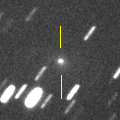
|
It brightened rapidly and became brighter than expected. Now it is 17.3 mag (Mar. 30, Thomas Lehmann). It is observable in good condition in the Northern Hemisphere. It locates somewhat low in the Southern Hemisphere.
Date(TT) R.A. (2000) Decl. Delta r Elong. m1 Best Time(A, h)
Apr. 24 6 11.29 18 17.8 2.485 2.149 59 17.9 20:10 ( 90, 33)
May 1 6 26.09 17 43.9 2.576 2.177 55 18.1 20:18 ( 92, 28)
|

|
Now it is 17.8 mag (Apr. 17, Taras Prystavski). In the Southern Hemissphere, appearing in the morning sky. It is already fading.
Date(TT) R.A. (2000) Decl. Delta r Elong. m1 Best Time(A, h)
Apr. 24 23 26.58 -8 29.5 2.551 1.972 44 18.0 3:46 (281, 1)
May 1 23 40.76 -7 27.7 2.534 2.007 48 18.3 3:36 (280, 2)
|

|
Now it is 18.6 mag (Apr. 4, Michael Jager). Although it is around the aphelion, it is much brighter than originally predicted.
Date(TT) R.A. (2000) Decl. Delta r Elong. m1 Best Time(A, h)
Apr. 24 10 44.57 10 41.4 4.776 5.413 124 18.3 20:34 ( 0, 66)
May 1 10 43.34 10 38.3 4.873 5.416 117 18.4 20:18 ( 8, 65)
|
|
![]()
 C/2020 Y2 ( ATLAS )
C/2020 Y2 ( ATLAS ) C/2020 H6 ( ATLAS )
C/2020 H6 ( ATLAS ) C/2018 N2 ( ASASSN )
C/2018 N2 ( ASASSN ) C/2020 S8 ( Lemmon )
C/2020 S8 ( Lemmon ) 15P/Finlay
15P/Finlay C/2021 A2 ( NEOWISE )
C/2021 A2 ( NEOWISE ) C/2017 Y2 ( PanSTARRS )
C/2017 Y2 ( PanSTARRS ) C/2019 T3 ( ATLAS )
C/2019 T3 ( ATLAS ) C/2020 O2 ( Amaral )
C/2020 O2 ( Amaral ) C/2019 O3 ( Palomar )
C/2019 O3 ( Palomar ) C/2019 U5 ( PanSTARRS )
C/2019 U5 ( PanSTARRS ) C/2020 N1 ( PanSTARRS )
C/2020 N1 ( PanSTARRS ) C/2020 M3 ( ATLAS )
C/2020 M3 ( ATLAS ) C/2020 V2 ( ZTF )
C/2020 V2 ( ZTF ) 413P/2020 W4 ( Larson )
413P/2020 W4 ( Larson ) 409P/2020 V1 ( LONEOS-Hill )
409P/2020 V1 ( LONEOS-Hill ) C/2017 U7 ( PanSTARRS )
C/2017 U7 ( PanSTARRS ) C/2021 A1 ( Leonard )
C/2021 A1 ( Leonard ) 417P/2021 B1 ( NEOWISE )
417P/2021 B1 ( NEOWISE ) 284P/McNaught
284P/McNaught P/2020 U2 ( PanSTARRS )
P/2020 U2 ( PanSTARRS ) C/2020 F2 ( ATLAS )
C/2020 F2 ( ATLAS ) C/2020 F7 ( Lemmon )
C/2020 F7 ( Lemmon ) 67P/Churyumov-Gerasimenko
67P/Churyumov-Gerasimenko C/2019 C1 ( ATLAS )
C/2019 C1 ( ATLAS ) 99P/Kowal 1
99P/Kowal 1 152P/Helin-Lawrence
152P/Helin-Lawrence C/2020 K1 ( PanSTARRS )
C/2020 K1 ( PanSTARRS ) C/2019 E3 ( ATLAS )
C/2019 E3 ( ATLAS ) 22P/Kopff
22P/Kopff C/2021 C3 ( Catalina )
C/2021 C3 ( Catalina ) 6P/d'Arrest
6P/d'Arrest P/2014 W12 ( Gibbs )
P/2014 W12 ( Gibbs ) C/2021 C4 ( ATLAS )
C/2021 C4 ( ATLAS ) C/2016 Q2 ( PanSTARRS )
C/2016 Q2 ( PanSTARRS ) 277P/LINEAR
277P/LINEAR 98P/Takamizawa
98P/Takamizawa 47P/Ashbrook-Jackson
47P/Ashbrook-Jackson![]()



























































